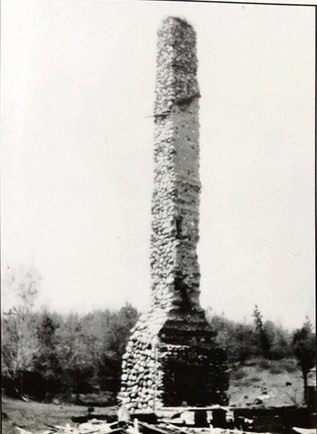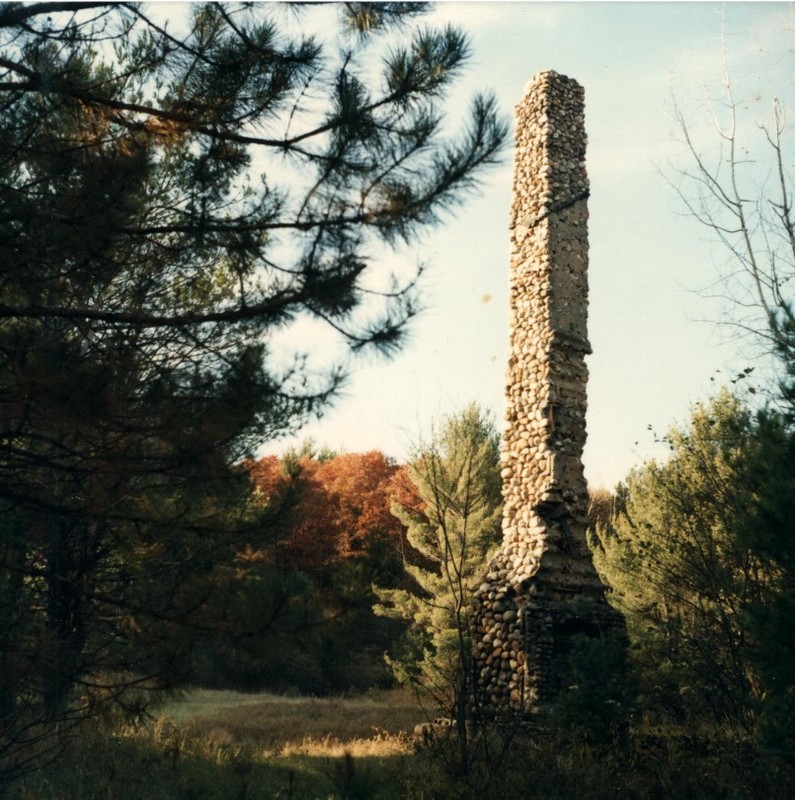Stevenson Farmstead
Introduction
Text-to-speech Audio
Arthur Stevenson's farm, along what is now Stevenson Creek, is one of the most complete and visible ruins of a farmstead in the Northern Highland American Legion Forest. The struggle of the Stevenson's buying a logging camp and attempting to farm the cutover is a typical Northwoods story from the early 20th century. Stevenson was unique in his attempt to grow cranberries, which has ultimately proven to be among the best crops to produce in Wisconsin's Northwoods. Sadly, the building was dismantled and sold as their farming venture failed. The chimney has been an iconic feature along Stevenson Creek and helped guide generations of canoeists on the journey between Trout and Pallett lakes.
PLEASE USE THE ALLTRALS MAP LINKED AT THE BOTTOM OF THIS CLIO ENTRY TO NAVIGATE THE ROUTE TO THE STEVENSON FARMSTEAD. THE GOOGLE MAP ROUTE IS LONGER AND LESS SCENIC.
It is illegal to dig, metal dectect or take artifacts on public lands without a permit from the DNR Archaeologist and State Archaeologist. Stevenson Farmstead is a cultural site. Observing, taking photos and sharing stories around the this exciting destination are encouraged.
Images
Stevenson Chimney

Stevenson Home in Boulder Junction

Area of Stevenson's Fam

Stevenson Chimney

Backstory and Context
Text-to-speech Audio
Arthur Stevenson was originally from Ionia, Michigan where his family owned a dry goods store. He wanted to venture off on his own and create his own business. The Stevenson family owned a farm on Madeline Island and were familiar with that part of Wisconsin. Emma and Arthur Stevenson created a dry goods and notion store on what is now Main Street in Ashland, Wisconsin. He lived above the store in 1890 and 1891. By 1897, Stevenson took on partners and the business became Stevenson, Dopp, and Watson & Co., selling dry goods, crockery and hardware. Another partner was added, and shoes sales became a part of the business. Later, the partnership split; Stevenson operated for a time on his own and by 1906 moved back to Ionia.
The family allegedly purchased 2500-2800 acres in Vilas County, including most of the area around Pallette, Nebish and Escanaba lakes.This land was described as mostly stumps and debris. The site had originally been a lumber camp, and bunk houses were on the property when they purchased it. Stevenson ran and improved a sawmill on his land and was one of the earliest pioneers to believe he could establish a cranberry farm in the area. Workers for the sawmill stayed in the bunk houses that were left from lumber camp days. In June of 1910, The State Board of Forestry noted that Stevenson requested to purchase land in the state forest reserves in sections 4 and 5 for the purpose of establishing a cranberry plantation. The land was put up for bid at not less than $4 an acre. Records are not clear if Stevenson acquired that particular land. Still, he established a bog along land next to Stevenson Creek. Phillip Barnard, his grandson, stated that the soil wasn’t right for cranberries and that the venture was not successful. Other crops raised were squash and potatoes. In 1915, Arthur and Emma left the farm and returned to Ionia, Michigan to run the family business. In 1929, they moved back to Boulder Junction and left the running of the family business in Ionia, Michigan to their eldest son, Rolland. Arthur died in 1935 and his wife Emma was living in Milwaukee when she sold the farm. In April 1944, the property was sold to John O’Leary for $15,400 and included 1,256.74 acres of the land and the house. O’Leary was a realtor and sold the land to the State of Wisconsin in June 1944, for $20,000.
What happened to the house? One version is that it burned, and another is that the state disassembled the building, and the logs were sold as mine timbers for mines in the Upper Peninsula.
The ruin at this site was once a 13-room log home built on a full basement. It was a three-story house with five rooms on the main floor, five rooms on the second floor and three rooms in the attic area. The full basement included a furnace. This home was considered by many to be one of the finest homes built in the Boulder Junction area at the turn of the 20th century.
Around 1911, Wilbur “Bill” Barnard was hired at the Trout Lake Ranger Station. According to his grandson, he was one of five rangers brought to Trout Lake by the Wisconsin Conservation Department. They worked to create the nursery that helped to reforest the woodlands of Wisconsin. In 1915, he married Ruth Stevenson, one of the Stevenson daughters. Bill was born in Nebraska and studied forestry at the University of Nebraska. He left the WCD for a time and returned in 1929 and worked at several stations. In the late 1930s, he returned to Trout Lake for a time and lived at the station.
Written by Kay Krans
Sources
Facebook, Facebook page, Boulder Junction photo album, Accessed June 12th, 2024. https://www.facebook.com/BoulderJunctionPhotos/photos/a.841100125923607/3199700150063581/?type=3&_rdr.
Interview with Elmer Dahlquist, at Trout Lake, Boulder Junction, Wisconsin, August 20 2022.
Boulder Junction, The Early Years, Friends of the Library, Boulder Junction, Wisconsin 1996.
A Walk Through the Stevenson Creek Chimney Ruins, Willow Adventures, https://www.you.tube.com/watch?v=eWeFmfjGA8I.
Boulder Junction, The Early Years, 1880s to 1950s
Boulder Junction, The Early Years, 1880s to 1950s
Vilas County GIS
Boulder Junction Facebook
